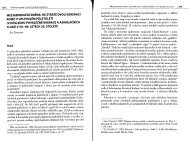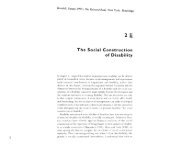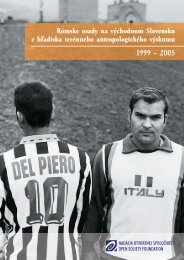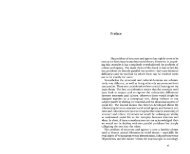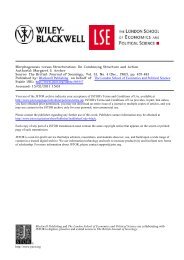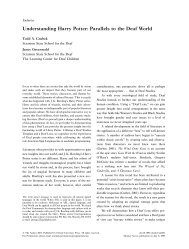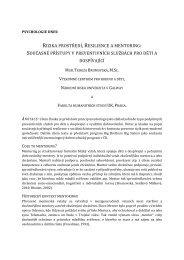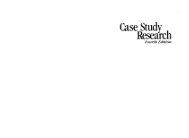Culture and Practical Reason Two Paradigms of ... - Moodle
Culture and Practical Reason Two Paradigms of ... - Moodle
Culture and Practical Reason Two Paradigms of ... - Moodle
- No tags were found...
You also want an ePaper? Increase the reach of your titles
YUMPU automatically turns print PDFs into web optimized ePapers that Google loves.
Chapter <strong>Two</strong> 60 Cuhure <strong>and</strong> <strong>Practical</strong> <strong>Reason</strong><strong>Two</strong> <strong>Paradigms</strong> <strong>of</strong> Anthropological Theory61(p. 509). Thus thought is recognition, <strong>and</strong> the mind a vehicle by whichnature is realized as culture.Morgan's further explication <strong>of</strong> the gens (clan) as a growth upon thebasis <strong>of</strong> the punaluan family <strong>and</strong> a codification <strong>of</strong>its advantages carriesto ahigher power exactly the same conception. As matrilineal, the originalgens represents the natural working out <strong>of</strong> the punaluan family overtime-given the impossibility <strong>of</strong> ascertaining paternity under the existingmarital conditions. The social concept <strong>of</strong> descent is once more an awareness<strong>of</strong> relationships already prevailing (p. 442). (Later in Morgan'sscheme descent will become patrilineal, under the influence <strong>of</strong> the growth<strong>of</strong> "property"-Morgan's general term for the possession <strong>of</strong> strategic"wealth"-which is the juncture at which economic interest, or the effectivedeployment <strong>of</strong>growing means <strong>of</strong>subsistence, takes over from biologicaladvantage as the practical determinant <strong>of</strong> social form.) Just like thepunaluan family, whose function in this respect it duplicates <strong>and</strong>generalizes, the gens worked its way into acceptance by the "advantages itconferred"-namely, the improved stock that must result from the rule <strong>of</strong>exogamy:It was evidently a primary object <strong>of</strong> the organization to isolate a moiety<strong>of</strong> the descendants <strong>of</strong> a supposed founder, <strong>and</strong> prevent their intermarriagefor reasons <strong>of</strong> kin.... The gens, originating probably in theingenuity <strong>of</strong> a small b<strong>and</strong> <strong>of</strong> savages, must have soon proved its utilityin the production <strong>of</strong> superior men. Its nearly universal prevalence inthe ancient world is the highest evidence <strong>of</strong> the advantages it conferred.[Ibid., pp. 73-74; cf. also pp. 68, 389,442]In turn, the Turanian kinship system reflects the organization on thebasis <strong>of</strong> punalua <strong>and</strong> the gens. By its distinction between parallel <strong>and</strong>cross-kin, it puts into words the differences already established in fact.Turanian kinship is no more than the faithful articulation <strong>of</strong> the socialdistinctions developed by natural selection.The theory can be summarized as follows: Men early developed certainpractices, forms <strong>of</strong> behavior such as the exclusion <strong>of</strong> own brothers <strong>and</strong>sisters from group sexual unions, which proved naturally useful <strong>and</strong> advantageous.The advantages were appreciated <strong>and</strong> the behaviors formulated asmodes <strong>of</strong> organization-for example, punaluan family, the gens-whichwere in turn subject to secondary reflection or codification in kinshipterminology. The general line <strong>of</strong> force in the argument, the orientation 0/logical effect, is from natural constraint to behavioral practice, <strong>and</strong> frombehavioral practice to cultural institution:1. circumstance-practice-organization <strong>and</strong> codification (institution).To underst<strong>and</strong> any given segment in the chain <strong>of</strong> effect, it is referred tothe reason in the segment preceding: as codification expresses organization,so the institutional structure as a whole is referred to practice <strong>and</strong>practice to experience in the world-such that the total sequence representsthe sedimentation within culture <strong>of</strong> the logic <strong>of</strong> nature (adaptiveadvantage). 2But then, Morgan's theory is appropriate to a nonhuman culture--orelse to a noncultural humanity. For just as thought is the recognition <strong>of</strong> anexternal significance, so the words <strong>of</strong> men are not the concept <strong>of</strong> externalrealities but the sign. Consisting merely <strong>of</strong> the capacity to act rationallyupon experience, the intelligence Morgan underst<strong>and</strong>s as human is notdifferent in kind from that <strong>of</strong> other mammalian species-especially thebeaver. In his famous monograph The American Beaver <strong>and</strong> His Works(1868), Morgan argued vigorously for the commonality <strong>of</strong> "the thinking. principle" in man <strong>and</strong> beast. The beaver's mental qualities, he wrote, are"essentially the same as those displayed by the human mind" (p. 252).The difference between these qualities <strong>and</strong> human thought, "<strong>and</strong>, inferentially,between the principles they respectively represent, is one <strong>of</strong> degree<strong>and</strong> not <strong>of</strong> kind" (ibid.). The specific resemblance consists in the ability tomake "a rational use" <strong>of</strong> perceptions conveyed by the senses, to actpragmatically on experience. Hence, for Morgan the source <strong>of</strong>significancethat is materialized in the species' productions, whether it be the house <strong>of</strong>African or beaver, lies in nature itself. Morgan returned repeatedly toanimal psychology, always concerned to show "that all species, includingthe human, receive immediate guidance/rom nature" (Resek 1960, p. 51;emphasis mine).3 His theory <strong>of</strong> knowledge was thus characterized by the2. More generally, since economic interest takes over from biological advantage in laterstages <strong>of</strong> Morgan's scheme, the base logic could be characterized simply as "practicaladvantage." From an ecological perspective, however, the difference is only betweenmodalities <strong>of</strong> adaptive advantage. (Indeed, one metaphor running from early man throughpatriarchial herders <strong>and</strong> capitalism is improvement <strong>of</strong> the stock.)3. Resek, Morgan's most penetrating biographer, makes a nice connection between therationality attributed to animals <strong>and</strong> Morgan's own anthropological epistemology. Distrustful<strong>of</strong> both instinct <strong>and</strong> imagination, Morgan's long work on social evolution leftuntouched the history <strong>of</strong> ideas, even as-supreme rationalist-he could consider thiswork itself untouched by ideology. Morgan "never doubted that his thoughts were truereflections <strong>of</strong> reality. That he was wealthy, at times in dissent, a Whig, had little if anybearingon what he saw at the base <strong>of</strong> the Rocky Mountains or in an Aztec pueblo. Hewould have cast out the notion that subjective, irrational or l\ubconscious factors made



